|
Set of domino tokens "A".
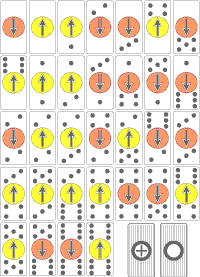
Deck of domino tokens "B".
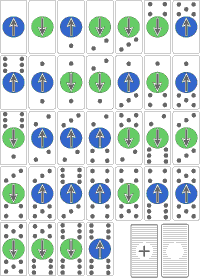
Chess board for dominoes.
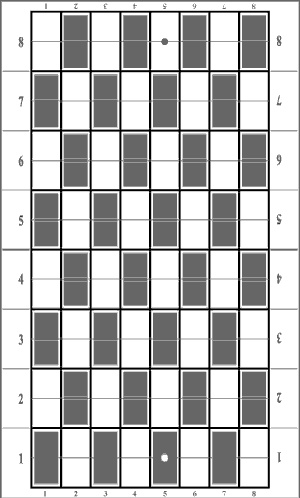
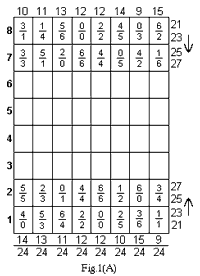
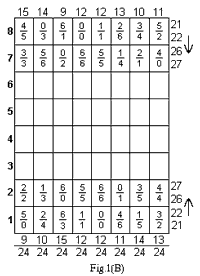 |
Description of design. This board game differs
from classical dominoes by presence of a checker-board, and also tiles
or tokens or playing cards with combinations of numbers are ordered and
designated by way of chessmen, that gives to players unusual potential
of gaming interactions.
Linear cross-sections of the checker-board have square forms which
correspond to shapes of domino tokens. The order of squares has
alternating as light and dark in staggered rows, that allows to see
diagonals during games or conundrums. The cross-section structure of
squares is subdivided with more thin linear marking which allows to
place tokens of dominoes in lengthwise or crosswise positions. On edges
of the board there are numerical notations which correspond to vertical
and horizontal rows, and also there are additional places on which
players too can place tokens of dominoes.
The checker-board of 8 vertical and 8 horizontal rows of squares lays in
the basis of this logic domino game. It is caused by that 64 squares are
optimal quantity for human perception, and such magnitude relation of
playing space is accepted for classical games with chessmen or draughts.
Known sets of 28 domino tokens with digital combinations from 0 to 6 for
the checker-board of 64 squares do not match, and consequently this game
design contains completes or decks of dominoes with some repeating
combinations of numbers.
It is necessary to tell that similar addition of repeating numerical
combinations has analogy to the Chinese domino which too contains 32
tokens or tiles, but structure of digital system in the Chinese variant
differs from complete sets of the present game design.
Doubles 0/0, 6/6, 2/2, 4/4 are added to one complete set which is named
with the letter “A”, and doubles 0/0, 6/6, 1/1, 5/5 are additional in
the second deck which is named with the letter “B”. Total each set
contains 32 tokens and corresponds to the checker-board of 8 vertical
and 8 horizontal rows, namely 32+32=64 dominoes can be completely compared to 64 squares.
Dominoes are mathematical combinations or numerical pairs of twofold
numbers. Combinations of identical numbers have the name "doubles", and
unequal digital pairs refer to "fractions". Numbers or digits are put on
domino tokens or tiles or printed playing cards in the form of points.
Tokens of two complete sets differ by color circles on front-face areas.
The set "A" has red and yellow circles, and the deck "B" has blue and green.
Two colors are necessary for designation of domino tokens of each
complete set to designate proportional groups of numerical combinations.
Namely numbers of 16 red and 16 yellow tokens in the deck "A", or also
digits of 16 blue and 16 green tiles in the set "B" are proportional.
Domino tokens of complete sets "A" and "B" on backs have distinctions by
dark and light circles, and proportional groups in structures of two
decks differ with presence and absence of daggers.
Players can choose two proportional groups from structure of any one
complete set, or players can choose two decks of domino tokens for
realization of games. Thus equal chances to win will be observed if each
player plays with tokens of dominoes of own complete set or proportional group.
Initial playing positions of proportional groups from structures of
complete sets "A" and "B" are shown in pictures 1(A) and 1(B). Tokens
of dominoes are represented in pictures in the Arabian ciphers within
the limits of schematic squares of checker-board.
As it is possible to see the shown initial playing positions are
similar to arrangements of chessmen before the beginning of chess game.
Tokens of dominoes in initial positions are directed by focusing arrows
on opponents, that is necessary for proportional orientation. As numbers
of dominoes according to focusing arrows can be directed forward or
back, but numerical parities are proportional if arrows have directions on opponents.
This rule is specified in pictures 1(A) and 1(B) by schematic arrows
at the right edge.
Players can not pay attention on the device construction or otherwise to
tell design of complete sets, but can place domino tokens on the
checker-board according to directions of focusing arrows, and in any
case interaction of dominoes and numbers will be proportional and
optimum in view of positional-tactical numerical parities which can
exist during games.
Because complete sets of domino tokens are "magic squares" of dominoes,
namely numbers in initial playing positions make natural or otherwise to
tell magic mathematical sums on verticals and horizontals, that is shown
in pictures 1(A) and 1(B) by ciphers on edges of schematic checker-board.
Magic sums of numbers on horizontals are shown at the right, and above
or below it is possible to see vertical sums.
It is necessary to tell that the shown magic squares of dominoes are
not inventions of abstract mathematicians as it has been told in one of
telecasts, but this digital design of domino systems are a part of the
patent for invention RU2259223.
Thus, this board game of dominoes has the magic mathematical order owing
to which two players can play with equal chances to win and completely
open playing information as in chess. And also it is possible to solve
various numerical conundrums and logic puzzles.
Images and pictures for variants of complete sets with main decks
of domino tokens or printed playing cards, and also game rules are
accessible for downloading in the form of PDF files.
-
Files oskru1.pdf and oskru2.pdf.
Rules of domino games are written in Russian, but in these PDF files there are
pictures for printing.
And look rules and manuals of some games and conundrums in English
language on HTM pages in spaces of this website.
Package of this game also contains third complete set of
domino tokens which digital system and design features can be seen on
corresponding page. The third deck of dominoes is more simple, but also
allows to play on a checker-board which has 64 cells as a chess.
I hope that the
offered domino gaming design will be entertaining and interesting to you!
The shown playing cards with images of domino digits are possible for
downloading as tabletop logic game for sports competitions and
tournaments, or otherwise to tell championships in which
participants solve intellectual conundrums and mathematical puzzles.
As numbers of dominoes on playing cards can be considered as a
mathematical construction by means of which organizers of competitions
can pose logic problems which are not identical, but have equal
complexity for all participants of intellectual tournament.
And also the shown decks of domino tokens can be considered as one of
game models for world championships and tournaments under aegis of the
International Federation of Dominoes. |